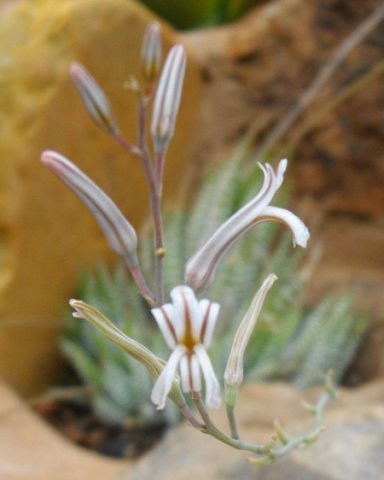Haworthiopsis attenuata var. attenuata flower

Author: Ivan Lätti
Photographer: Thabo Maphisa
This flower of Haworthiopsis attenuata var. attenuata was photographed during November, spring being the normal blooming season for the species. The height of the inflorescence is around 40 cm when all is well with the plant. The peduncle may be branched, producing multiple racemes in a panicle.
There may be more than 20 flowers in one raceme. They are spirally arranged and two flowers open at a time, beginning at the bottom. The perianth tube is white with a green to brown keel down the centre on the outside of each corolla segment. The flower tube is narrow and long, about 1,5 cm when fully developed. When the flower opens, the segment tips recurve as in the picture.
The arrangement of three inner and three outer tepals (or perianth segments) is shared with other Asphodelaceae flowers, such as the aloes and also the bigger grouping of the lilies, the larger family that once included Asphodelaceae.
As with living plants in nature, so with human taxonomical systems of the natural world, such systems are also living but approximating, following and never equalling nature. They are never complete and easily die when they become static.
One small step was added in 2013 in the quest of catching up with nature regarding the Haworthia genus by the separation of 18 species into their own genus. The earlier subgenus of the Hexangulares were placed in the new genus of Haworthiopsis. This was done on account of the outcome of phylogenetic studies indicating separate ancestors for members of the two genera.
The vertical arrangement of the corolla segments, a hallmark of the haworthias (and now also of the haworthiopsises) can, however, still be observed in the photo: one inner and two outer segments above and two inner and one outer segments below in the two-lipped flower. The outer segments of the lower lip in picture lack the central brown-purple bands (Smith, et al, 2017; Scott, 1985; iNaturalist; http://redlist.sanbi.org).

